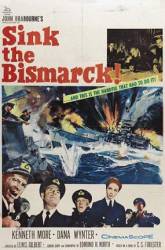Factual error: The vertical steel I-beams in the command centre are riddled, as it were, with rivets, but the rivets do not attach the I-beams to anything and are obviously just set decoration.
Character mistake: At the end, as Kenneth More and Dana Wynter emerge from the command centre, they are surprised to find that it is 9 AM, not 9 PM. Since all military and naval forces use a 24-hour clock, they would have known that the time was 0900, not 2100.
Factual error: Here's a big historical mistake. The character of German Admiral Lütjens is depicted overall in this film as a wild-eyed Nazi fanatic. In real life, he was distinctly anti-Nazi, vehemently protested the anti-Semitic actions of Hitler's regime, and was himself subject to intense Nazi scrutiny as he was a quarter Jewish and his wife was half Jewish. He was one of many German naval officers who fought only for their country, not Hitler.
Continuity mistake: The Bismarck is sighted by a British agent in southern Norway, sailing out of the Baltic into the North Sea - east to west. But the view through the agent's binoculars shows the ship sailing from right to left on the screen - which would be sailing west to east from the point of view of an observer on the Norwegian coast.
Factual error: The battle of the Denmark Strait is wrong in that both sides are heading and shooting in the wrong direction. The Germans are shooting to starboard rather than port, and the British are shooting to port rather than starboard.
Factual error: In the film, the Bismarck destroys a British destroyer. She also shoots down one or more Swordfish torpedo aircraft. In reality, she sank only one ship (Hood) and lightly damaged a few others. No aircraft were shot down.
Continuity mistake: Near the beginning a reconnaissance Spitfire overflys a Norwegian fjord, taking high altitude photos of the ship. The movie cuts to the photo lab, where a technician develops the photo. The fjord and the ship can be seen in the tray. However when the technician and his assistant remove the print and study it, you can see (through the back) that this is not the aerial shot just seen, but is a picture of the ship from sea level as viewed from another ship.
Factual error: The destroyer allegedly sunk by the Bismarck is named as the Solent. She would not have been much use in a 1941 torpedo attack, as she had no torpedoes and was not completed until 1944.
Other mistake: When the planes from the carrier Ark Royal first spot a ship through a hole in the cloud cover we see a ship sailing along. (The Sheffield, which they mistakenly attack). Later, they supposedly spot the Bismarck, yet we see exactly the same ship sailing along through the same hole in cloud cover.
Factual error: The admiralty gets a priority message that two ships have been seen leaving the Baltic. The admiral and his chief of staff discuss "the Crete business", however the Bismarck sortied on 18 May, 1941, and the invasion of Crete happened two days later.
Factual error: HMS Rodney which along with KGV sank the Bismarck is wrongly portrayed. Her 16 inch guns were all forward of the main superstructure.
Suggested correction: The Rodney was a Nelson class battleship all her guns were forewarning of the superstructure.
Factual error: The Director of Operations is handed a fuel state for KGV and Rodney, and is advised they are 140 miles astern of Bismarck. He asks if they steam at full speed can they catch her. Since Bismarck can steam at 30 knots, and the British ships at 28 and 23 knots respectively, it was a question that shouldn't have even been broached.
Suggested correction: Because of damage to her fuel tanks from Prince of Wales Bismarck had to reduce speed to 20 knots.
Factual error: Just prior to the sinking, men are scrambling on the burning deck, beneath a tall, fairly slim (and lonely) funnel that bears no resemblance to that of the Bismarck.





